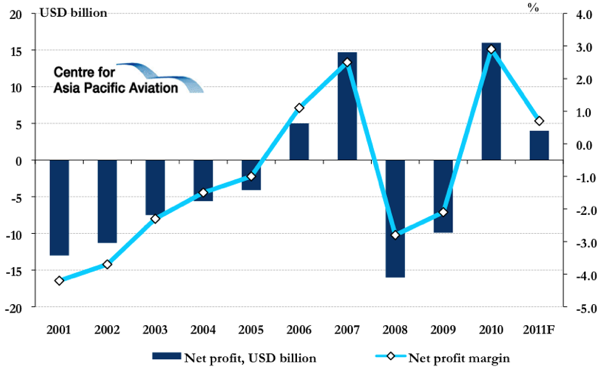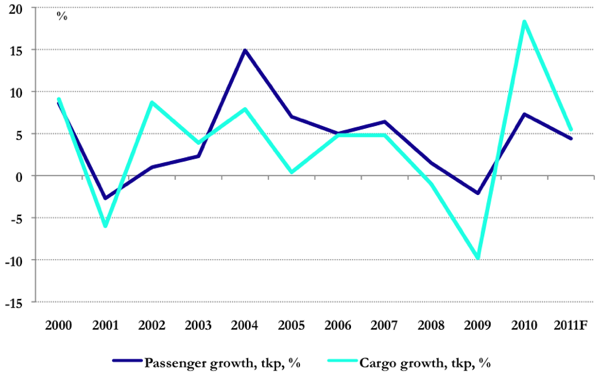IATA halves profit forecast for 2011; 78% weaker than 2010
IATA more than halved its forecast for airline industry net profits in 2011 to USD4 billion, with passenger and cargo demand seen to be weaker than previous estimates announced in Mar-2011. IATA cited the impact of high fuel costs, unrest in the Middle East and the impact of Japan's 11-Mar-2011 earthquake and tsunami for the 54% reduction in its outlook from the USD8.6 billion profit forecast in Mar-2011.
- IATA has revised its forecast for airline industry net profits in 2011 to USD4 billion, down from the previous estimate of USD8.6 billion.
- High fuel costs, unrest in the Middle East, and the impact of Japan's earthquake and tsunami are cited as reasons for the reduced profit outlook.
- Fuel costs are the main cause of reduced profitability, with fuel expected to represent 30% of industry costs in 2011.
- Global passenger demand is expected to grow by 4.4% in 2011, down from the previous forecast of 5.6%.
- Asia Pacific is forecasted to be the most profitable aviation market in 2011, although the profit estimate has been reduced from USD3.7 billion to USD2.1 billion.
- Africa is the only region expected to post a loss in 2011, with a projected loss of USD100 million.
IATA global net profit outlook development for 2011
|
Region |
Previous 2011 forecast (Sep-2010) |
Previous 2011 forecast (Dec-2010) |
Previous 2011 forecast (Mar-2011) |
Current 2011 forecast (Jun-2011) |
|---|---|---|---|---|
|
Global |
USD5.3 billion |
USD9.1 billion |
USD8.6 billion |
USD4.0 billion |
|
Break even |
USD100 million |
USD500 million |
USD500 million |
|
|
USD1.4 billion |
USD3.2 billion |
USD3.2 billion |
USD1.2 billion |
|
|
USD3.0 billion |
USD4.6 billion |
USD3.7 billion |
USD2.1 billion |
|
|
USD600 million |
USD700 million |
USD300 million |
USD100 million |
|
|
USD300 million |
USD400 million |
USD700 million |
USD100 million |
|
|
Break even |
USD100 million |
Break even |
(USD100 million) |
The world's airlines are now expected to report a USD4 billion in profit in 2011 on sales of USD598 billion, for a "dismal" margin of 0.7%. CEO and director general Giovanni Bisignani stated that with such a weak margin, "there was little buffer left against further shocks".
IATA, whose members account for 93% of global passenger traffic, in Mar-2011 forecast global profits of USD8.6 billion in 2011, marking a decline from a Dec-2010 forecast of 9.1 billion. IATA members reported a combined net profit of USD18 billion in 2010 (revised from USD16 million), meaning the 2011 result will mark a 78% slump on last year's profit levels.
IATA net profit and net profit margin: 2001 to 2011 forecast
Challenging start to 2011
"Natural disasters in Japan, unrest in the Middle East and North Africa, plus the sharp rise in oil prices have slashed industry profit expectations to USD4 billion this year. That we are making any money at all in a year with this combination of unprecedented shocks is a result of a very fragile balance. The efficiency gains of the last decade and the strengthening global economic environment are balancing the high price of fuel," Mr Bisignani said.
"This year started in a very difficult way with the unrest in the Middle East and the crisis on fuel," Mr Bisignani added in an interview with Bloomberg Television. The aftermath of the 11-Mar-2011 earthquake in Japan, which accounts for almost 10% of global airline sales, has also been a "nightmare", he said.
Fuel to represent 30% of industry costs as forecast raised
The cost of fuel, however, is the main cause of reduced profitability. IATA has raised its forecast for the average price of Brent crude from USD96 to USD110 per barrel, marking a 15% increase over the previous forecast.
Every USD1 increase in the price of Brent crude adds USD1.6 billion to industry costs, IATA said. The rising price of oil means that fuel will account for 30% of industry costs this year, compared with 13% a decade ago. The industry 2011 fuel bill will rise by USD10 billion to USD176 billion in 2011, despite an estimated 50% of airline fuel requirements in 2011 being hedged at 2010 levels.
On a more positive note, Mr Bisignani stated the industry has "built enormous efficiencies over the last decade. In 2001, we needed oil below USD25 per barrel to be profitable. Today, we are looking at a small profit with oil at USD110 per barrel."
Yield growth forecast upwardly revised
In another positive development, robust economic conditions have given airlines some scope to partially recover higher fuel prices. IATA has increased its forecast for global GDP growth in 2011 from 3.1% to 3.2%, although this will be negated by high fuel costs and rising fares were hurting demand.
This is reflected in an increased yield growth forecast of 3% for passenger traffic (double the previously forecast 1.5%) and 4% for cargo (up from the previously forecast 1.9%).
However, IATA noted that "the problem is that higher travel costs are now weakening price-sensitive demand and airlines are not expected to be able to offset higher costs with increased revenues".
Passenger and cargo growth forecast downgraded
IATA now expects passenger demand to grow 4.4% in 2011, down from a forecast of 5.6% in Mar-2011. Premium passenger growth has dipped from the 9% of 2010, but is expected to be close to the historical trend in 2011 at a 5-6% rate. The volume of leisure travellers has fallen by between 3% and 4% over the past five months as travel costs were increased due to higher fuel costs and in Europe, new passenger taxes.
Global airline capacity is expected to increase by 5.8% in 2011, which is above the 4.7% anticipated demand increase. The gap between capacity and demand growth has widened to 1.1 ppts from 0.3 ppts in the previous forecast.
Due to schedule commitments and fixed costs, capacity adjustments are expected to continue lagging behind the fall in demand, driving load factors down. By Apr-2011, passenger load factors were hovering around 77%. This is more than a full percentage point below the 78.4% achieved for international traffic in 2010. Aircraft utilisation is also falling. This decline in asset utilisation is the most significant downward pressure on airline profitability.
The cargo growth forecast was cut from 6.1% to 5.5%.
IATA passenger demand and cargo demand growth: 2000 to 2011 forecast
Asia Pacific to remain most profitable aviation market
Economic growth in China and India means that Asia Pacific will still be the most profitable aviation market this year, according to IATA forecasts. However, IATA has reduced its forecast for the region from USD3.7 billion to USD2.1 billion. Elsewhere, IATA reduced its forecast for North American carriers' profits by 63% to USD1.2 billion and cut its Middle East profits estimate by 86% to USD100 million. IATA left its forecast for European carriers' profits unchanged at USD500 million.
IATA profit forecast and commentary by region
|
Region |
Profit forecast |
Traffic forecast |
Commentary |
|---|---|---|---|
|
Will deliver a USD500 million profit, down from USD1.9 billion in 2010. |
A capacity increase of 4.8% is expected to outstrip demand growth of 3.9%. |
The sovereign debt crisis is dampening demand from the peripheral European economies. Core economies are benefiting from strong exports, but new and increased taxation of passengers is damaging price-sensitive demand. Much of the profit forecast for 2011 will likely be generated on more buoyant long-haul markets. |
|
|
Will see the USD4.1 billion profit of 2010 fall to USD1.2 billion. |
Careful capacity management is expected to see an overall demand increase of 4% balanced by an equal increase in capacity |
The region's carriers are being hit on the cost side by rising fuel prices, exacerbated by an older, less fuel-efficient aircraft fleet. The region is also taking a hit on the demand side with 12% of international revenues linked to the Japan market. This is being offset somewhat by a stronger than expected US economy and stronger inbound demand and exports fueled by the weak US dollar. |
|
|
Expected to earn USD2.1 billion-the most profitable of all regions. Even so, this is dramatically down from the USD10 billion profit that the region achieved in 2010. |
The continued dynamism of these economies means that Asia Pacific is the only region where demand increases (6.4%) are expected to outpace capacity growth (5.9%). |
Airlines in this region are more exposed than others to cargo markets and fuel price fluctuations. Asia Pacific airlines carry 40% of all air freight volumes, while low labor costs and relatively low hedging means fuel accounts for a bigger proportion of total costs. In addition, the Japanese earthquake and tsunami are expected to dent the region's prospects for the remainder of the year. However, this will be more than offset by robust growth in China and India. |
|
|
Will be the only region to deliver a third consecutive year of profits. But a USD100 million profit is down considerably on the USD900 million profit of 2010. |
Capacity growth of 6.9% will outstrip the 6% increase growth in demand. |
The regional economies continue to show good growth, and trade links with the US and Asia in particular are boosting traffic. Innovative business models and consolidation have combined to generate reasonable profits from these growing markets. |
|
|
Will deliver a USD100 million profit, down from USD900 million in 2010. |
Capacity growth of 15.5% is expected to outstrip demand expansion of 14.6%. |
Political unrest in parts of the region is hurting demand. The major airlines in the region are expected to continue to win market share on long-haul markets, flying passengers via Middle Eastern hubs. However, high fuel costs will weaken demand from key passenger segments and asset utilisation will be under downward pressure. |
|
|
Forecast to be the only region to post a loss, at USD100 million, in 2011. |
Capacity growth of 7.4% will outstrip demand growth of 6.5%. |
Political unrest across Northern Africa is dampening demand, particularly in Egypt and Tunisia, which have proportionately large tourism industries. Economies and air transport demand in many African countries have grown strongly but the local industry has struggled to turn this into profitable growth, hampered by poor infrastructure and restrictive government regulation. |

